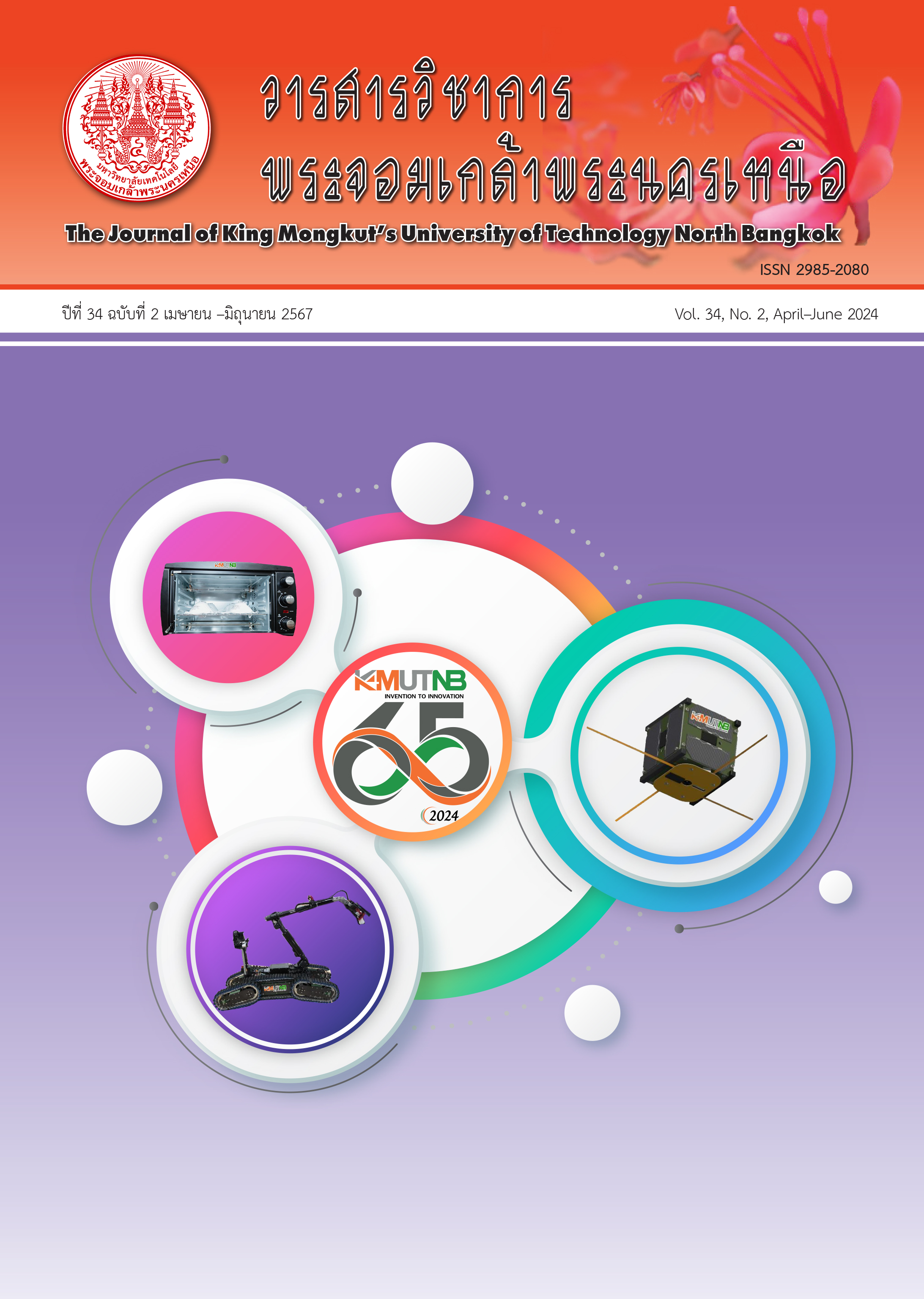การประเมินปริมาณวัสดุจากของเสียแผงเซลล์แสงอาทิตย์ที่หมดอายุการใช้งานในประเทศไทย
Main Article Content
บทคัดย่อ
แผงเซลล์แสงอาทิตย์กลุ่มผลึกซิลิกอนถือเป็นเทคโนโลยีนิยมใช้มากที่สุดทั้งในต่างประเทศและในประเทศไทย สำหรับแผงกลุ่มผลึกซิลิกอนประกอบด้วย 2 รูปแบบหลัก ได้แก่ ซิลิกอนผลึกเดี่ยว และซิลิกอนผลึกรวม ซึ่งแผงในกลุ่มผลึกซิลิกอนมีองค์ประกอบหลัก ได้แก่ กระจก กรอบอะลูมิเนียม แผ่นเซลล์ซิลิกอน วัสดุห่อหุ้ม (EVA) แผ่นปิดด้านหลังและซิลิโคน รวมถึงโลหะมีค่า (ทองแดง และเงิน) สำหรับประเทศไทยใน พ.ศ. 2550 เป็นปีที่เริ่มมีการสนับสนุนระบบผลิตไฟฟ้าแผงเซลล์แสงอาทิตย์ที่ติดตั้งบนพื้นดินแบบเชื่อมต่อระบบจำหน่ายตามนโยบายของรัฐ เห็นได้ว่าในอนาคตประเทศไทยมีแนวโน้มที่จะเผชิญกับปัญหาของเสียจากแผงเซลล์แสงอาทิตย์ในปริมาณมาก งานวิจัยนี้มีวัตถุประสงค์เพื่อการประเมินปริมาณวัสดุจากของเสียแผงเซลล์แสงอาทิตย์ที่หมดอายุการใช้งานในประเทศไทย เพื่อเป็นแนวทางในการพัฒนาระบบการจัดการของเสียแผงให้สามารถนำกลับของวัสดุที่มีค่าและเป็นที่ต้องการในท้องตลาดแทนที่การนำไปฝังกลบ ช่วยให้เกิดระบบเศรษฐกิจหมุนเวียนได้ในอนาคต โดยพิจารณาจากปริมาณของเสียแผงที่เกิดขึ้นจากข้อมูลการใช้แผงระหว่าง พ.ศ. 2550–2562 และค่าเฉลี่ยน้ำหนักองค์ประกอบของแผง ผลการดำเนินงานพบว่า ภายใน พ.ศ. 2582 จะมีปริมาณของเสียแผงสะสมสูงถึง 237,394 ตัน (ไม่รวมปริมาณของเสียแผงชำรุด) มีปริมาณกระจกมากที่สุด 163,921 ตัน ตามด้วยอะลูมิเนียม แผ่นเซลล์ซิลิกอน ทองแดง (ริบบอน) และเงินอยู่ที่ 30,007 7,620 2,089 และ 119 ตัน ตามลำดับ สำหรับวัสดุพอลิเมอร์ (วัสดุห่อหุ้ม แผ่นปิดด้านหลังและซิลิโคน) มีปริมาณรวมกัน 31,384 ตัน นอกจากนี้ยังพบว่า มีปริมาณตะกั่วที่ถือเป็นมลพิษ (สัดส่วนของตะกั่วร้อยละ 0.06 ของน้ำหนักแผง) สะสมถึง 142 ตัน
Article Details

อนุญาตภายใต้เงื่อนไข Creative Commons Attribution-NonCommercial-NoDerivatives 4.0 International License.
บทความที่ลงตีพิมพ์เป็นข้อคิดเห็นของผู้เขียนเท่านั้น
ผู้เขียนจะต้องเป็นผู้รับผิดชอบต่อผลทางกฎหมายใดๆ ที่อาจเกิดขึ้นจากบทความนั้น
เอกสารอ้างอิง
N. Buranasingha, (2019, July). Solar panels: toxic waste should not be overlooked. [Online]. (in Thai). Available: www.parliament.go.th/ ewtadmin/ewt/parliparli_parcy/ewt_dl_link. php?nid=51485&filenamf=thai_national_ assembly
Environmental Impact Prevention Guidelines and Waste Disposal Methods from Solar Power Projects for Thailand Manual, Development and Efficiency, Ministry of Energy, Thailand, pp. 1–29, 2017 (in Thai).
W. Stephanie, W. Andreas, and H. Garvin. (2020, April). End-of-Life Management: Solar Photovoltaic Panels (IEA-PVPS Task 12). [Online]. Available: www.irena.org/publications/ 2016/Jun/End-of-life-management-Solar- Photovoltaic-Panels
P. Rachadawong, S. Ratanathammaphan, D. Banjerdpongchai, T. Boonpramote, and S. Sampattavanija. (2016, September). Management of expired solar PV panels. Thailand Science Research and Innovation. Bangkok. [Online]. (in Thai). Available: https://elibrary.trf.or.th/project_content. asp?PJPJ=RDG58D0006
B. Wiengmoon, “Analysis of solar cells deterioration,” Doctor of Philosophy, School of Energy, Environment and Materials, King Mongkut's University of Technology Thonburi, Bangkok, Thailand, 2010 (in Thai).
Information and Communication Technology Center Department of Alternative Energy Development and Efficiency, Ministry of Energy. (2021, April). Energy Balance of Thailand 2020. [Online]. (in Thai). Available: https://webkc. dede.go.th/testmax/node/5736
Development and Efficiency, Ministry of Energy, Thailand PV Status Report B.E. 2561, pp. 1–58, 2018 (in Thai).
M. Pibanwong, “Expired/damaged Solar Cell Management: A case study of Ubonratchatanee Province,” Master of Science (Environmental Management), National Institute of Development Administration, Bangkok, Thailand, 2016 (in Thai).
V. Tan, P. R. Dias, N. Chang, and R. Deng, “Estimating the lifetime of solar photovoltaic modules in Australia,” Sustainability, vol. 14, no. 9, pp. 1–19, 2022.
C. C. Farrell, A. I. Osman, R. Doherty, M. Saad, X. Zhang, A. Murphy, J. Harrison, A. S. M. Vennard, V. Kumaravel, A. H. Al-Muhtaseb, and D. W. Rooney, “Technical challenges and opportunities in realizing a circular economy for waste photovoltaic modules,” Renewable and Sustainable Energy Review, vol. 128, pp. 1–18, 2020.
V. Fiandra, L. sannino, C. Andreozzi, and G. Graditi, “End-of-life of silicon PV panels: A sustainable materials recovery process,” Waste Management, vol. 84, pp. 91–101, 2019.
A. Paiano, “Photovoltaic waste assessment in Italy,” Renewable and Sustainable Energy Review, vol. 41, pp. 99–112, 2015.
Ç. Gönen, and E. Kaplanoğlu, “Environmental and economic evaluation of solar panel wastes recycling,” Waste Management & Research, pp. 1-7, April 2019.
T. Maani, I. Celik, M.J. Heben, R.J. Ellingson, and D. Apul, “Environmental impacts of recycling crystalline silicon (c-SI) and cadmium telluride (CDTE) solar panels,” Science of the Total Environment, vol. 735, pp. 1–11, 2020.
J. D. Santos and M. C. Alonso-García, “Projection of the photovoltaic waste in Spain until 2050,” Journal of Cleaner Production, vol. 196, pp. 1613–1628, 2018.
H. Kim and H. Park, “PV waste management at the Crossroads of circular economy and energy transition: The case of South Korea,” Sustainability, vol. 10, no. 10, pp. 1–15, 2018.
Kasikornresearch. (2020, November). What to do with the solar panel waste problem. [Online]. (in Thai). Available: https://www. kasikornresearch.com/th/analysis/k-socialmedia/ Pages/FB-sola-30-01-20.aspx
F. Cucchiella, I. D’Adamo, and P. Rosa, “End-oflife of silicon PV panels: A financial analysis,” Renewable and Sustainable Energy Reviews, vol. 47, pp. 552–561, 2015.
Energy Regulatory Commission. (2022, March). SPP/VSPP database system. [Online]. (in Thai). Available: http://www.erc.or.th/ERCSPP/ ListDetail.aspx?
C. Farrell, A. I. Osman, X. Zhang, A. Murphy, R. Doherty, K. Morgan, D. W. Rooney, J. Harrison, R. Coulter, and D. Shen, “Assessment of the energy recovery potential of waste Photovoltaic (PV) modules,” Scientific Reports, vol. 9, no. 1, pp. 1–14, 2019.
Thai Gasifier. (2022, June). The heating value of various sources. [Online]. (in Thai). Available: http://www.thaigasifier.com
Investing. (2022, June). Forward contract of West Texas Intermediate (WTI) crude oil. [Online]. (in Thai). Available: https://th.investing. com/commodities/crude-oil-historical-data
Bangkok of Thailand. (2022, June). Average exchange rate. [Online]. (in Thai). Available: www.bot.or.th/App/BTWS_STAT/statistist/ BOTBOTWEBS.aspx?reportID=123&language=TH
S. Uçar, A. R. Ozkan, J. Yanik, and S. Karagöz, “The influence of the waste ethylene vinyl acetate copolymer on the thermal degradation of the waste polypropylene,” Fuel Processing Technology, vol. 89, no. 11, pp. 1201–1206, 2008.
S. Ratner, K. Gomonov, S. Revinova, and I. Lazanyuk, “Eco-design of energy production systems: the problem of renewable energy capacity recycling,” Applied Sciences, vol. 10, no. 12, pp. 1–29, 2020.

